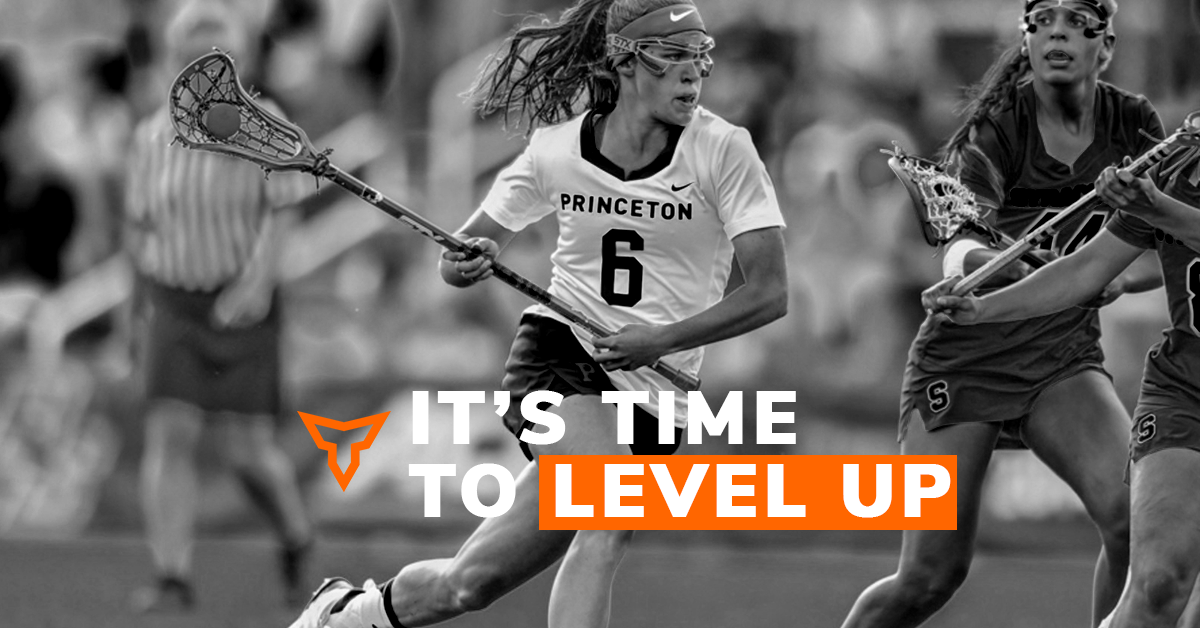From the GA's Desk: Standing by Your Femininity as a Female Strength and Conditioning Coach
Author Makena Ohlmaier is a Graduate Assistant Strength and Conditioning Coach with Springfield College.
We will begin with a quick exercise. Close your eyes for a moment and picture a strength and conditioning (S&C) coach. Picture anthropomorphic characteristics, hairstyle, garments, the sound of their voice, their physical presence, certain personality traits…
I am willing to bet that when you closed your eyes, you pictured a larger-sized white male. He likely had his hair cut short, the body typical of a powerlifter or strongman, and a loud, booming voice. While I cannot guarantee whether you pictured the coach with or without glasses, I can almost guarantee that the coach you pictured was not female. And, in the (rare) case that she was female, the chance that she was depicted in a feminine appearance is slim to none.
Another example: Google search “strength and conditioning coach,” and take a quick peek at the images that come up. Notice anything?
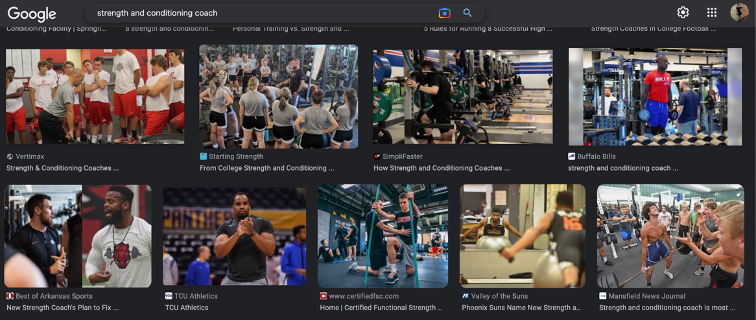
While more schools and institutions are recognizing the value of S&C and the impact it can have on athletic performance and overall development, a caveat to the field’s growth lies in the homogeneity of its staffing. As of 2021, 86% of all S&C coaches were men, and at the NCAA DI level, only 14% were women (Figueroa & Roper, 2022). These statistics are staggering, considering the evolution of women in typically male-dominated fields. Part of the imbalance stems from most women not recognizing S&C as a career option, particularly because of how much they would stand out from the crowd.
Okay, now picture this. You walk into a collegiate weight room and see a woman with a narrow body frame, recently colored hair twisted up in a colorful clip, and nails manicured neon pink. Her eyebrows are recently waxed, her shoes are bright yellow, and she is wearing leggings with a top that coordinates well. She has a full face of makeup on and does not shy away from displaying a series of sparkly earrings and rings. Her physique is lean and slim; one that makes you ponder whether she either can’t pick up more than a 20-pound dumbbell or easily lifts heavy every other day. Her presence is more reserved, and you can tell she may not be the rowdiest one in the room.
Upon first glimpse, you would likely think, “who is this chick, and what is she doing in the weight room?” Well, that person is me. I defy all stereotypes, expectations, and societal norms of what an S&C coach should (and currently still does), look like. Rather than suppressing my femininity, I embrace it. My femininity is exactly what makes me stand out like a sore thumb.
You may be thinking, so what? What’s the issue? I don’t have a problem with a feminine S&C coach…
Well, one of the concerns lies in the fact that I am not the typical depiction of a female S&C coach. That is because more often than not, female coaches are obliged to combat stereotype-breaching through impression management (Goffman, 1959) to ‘fit in’ and ‘become part of the S&C club.’ Stereotype breaching is exactly what I do when I step into the weight room; my feminine appearance and demeanor ‘breaches’ the masculine standards. So, to avoid social dissonance, female coaches present a hyper-masculinized version of themselves (Figueroa & Riper, 2022; Fisher, 2021; Thomas et al., 2021). Presenting as masculine stereotypes occurs because there is a specific demeanor and appearance that matches S&C stereotypes that females must align with to gain respect, trust, authority, credibility, and a voice, within the field. This may look like abbreviating names to display a gender-neutral identity (Thomas et al., 2021), maintaining a specific physique, and stripping any display of femininity from their image (Figueroa & Riper, 2022). It likely means they feel the need to outwardly display their physical strength and prowess to avoid others doubting their place. Reserved, individual-focused coaches may feel the need to present with more aggression and assertiveness and overcompensate through an authoritative presence. Frequently, humor (specifically banter) is used to mask the resonating dissonance, discomfort, and latent sexism that’s internalized when presenting themselves in this way (Fisher, 2021; Thomas et al., 2021).
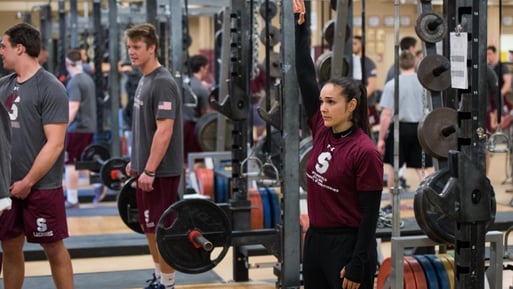
It's not just females suppressing femininity on their own accord; institution regulations labeling feminine appearance as “inappropriate” and “distracting” are commonplace. Protocols generally include prohibition of painted nails, leggings, makeup, jewelry, and require females to have all tops fully zipped up. Some coaches even report buying and wearing men’s clothing because all other options were made unavailable (Figueroa & Roper, 2021). However, ironically, men’s shorts are becoming shorter, and highly placed thigh tattoos becoming more visible, with no sign of this change being considered. Conforming to masculinized standards permits women to become part of the ‘boys’ club’ that is S&C. Yet isn’t such alignment to the stereotype perpetuating the exact stereotypes women are fighting against?
Well… yeah, it is… But at the same time, how are women supposed to gain respect, authority, credibility and fit in, all while upholding their femininity, transgressing societal expectations, and standing out like a red rose in a field of grass? How are we to feel comfortable and as though we belong in such a setting?
The answer is not so clear cut. Still, I am going to propose some tips on how to find, live, and coach, your truth.
1. Focus on Building Relationships
One commonality between most female coaches is that their favorite part of the job is the ability to build relationships. So, place your focus on the athletes. Rather than attempting to be the biggest, loudest coaching presence in the room, give attention to each individual athlete. Do not shy away from the part of the job that actually has the longest-lasting impact. You will ‘prove’ you belong by doing the part of the job that you love most. Of course, writing the programs and actively coaching can’t be neglected. But you do not have to present certain behaviors, mannerisms, and coaching styles that do not match who you are as an individual and as a coach. And, who knows, through the relationships you build, you will very likely be encouraging and mentoring future female S&C coaches!
2. Wear What You Feel Most Comfortable and Confident in
Do not be afraid to wear leggings, non-baggy tops, and your bright-colored shoes that put a smile on your face. If you are comfortable and confident, you will exude these emotions to your athletes through the way you coach. If you are uncomfortable and feel hidden, chances are that you will coach that way too. Remind yourself that it is not your responsibility to dress in a way to minimize male distraction. Nonetheless, if your outfit does distract a man from their task, it is on them, not you.
3. Build a Network of Female Coaches That You Trust
Having a support network filled with people who get it is crucial. Don’t know where to start? That’s okay! I have found the best way to get started building your network is… Google. All it takes is one connection to get the ball rolling. A total snowballing effect! Start with one coach. Do a little digging on who they are and their coaching style. Find their email and send them a short introduction to who you are along with few things you’re passionate about that you would like to discuss/learn more about. Ask to set up a time to chat and provide times you are available throughout the next week. Go into your meeting with a few questions prepared ahead of time, but also be ready to share your story, interests, passions, and goals. End the conversation by asking who they would recommend reaching out to, and make sure to keep in contact with them. Maintaining contact may look like emailing them random updates on topics you discussed, asking for book recommendations… nearly anything! Continue to reach out, and do not be afraid to ask people to set up Zooms, FaceTimes, or Google Meets. It shows that you care, are engaged, and eager to learn from others.
4. Keep Your Nail Polish on
(…And acrylics too.) Don’t let the boys bully you out of your forms of expression, self-love, and self-care. Be unapologetic about that neon pink nail polish. Be the example that those who wear acrylic nails do indeed still know what they are talking about in the weight room. News flash: it is possible to be a coach (and lift perfectly well) even though your nails are slightly longer than average. Your nails are not a sign of weakness and are not a symbol of frailty. On the contrary, they proclaim courage.
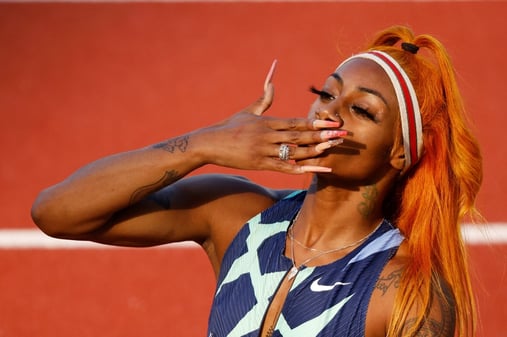
5. Embrace the Physique That is Healthy and Natural for You
Now, this one is tough. On the one hand, social media has proclaimed that female physiques are supposed to be slim, fit, and emulate ‘fitness influencer’ features. On the other, female S&C coaches are expected to align with strongman and powerlifter body types: i.e., be ‘physical proof’ that you know what you’re talking about. If you are naturally built on the narrow, slender side, people will question your credibility because you don’t look like a strength coach. They will assume you only program based on what is trendy. Yet if you are naturally of broader build, others presume you will immediately fall into the masculinized, stereotypes of female S&C coaches. My advice to you is to embrace the body you want to have and that is healthy for you. For this, there is no standard. You set your own standard. Health looks different for everyone, and workouts are prioritized differently for everyone. Live your truth and be comfortable in your own skin; there is nothing more important!
6. Don the Makeup That Makes You Feel Your Best (Even if that’s none at all!)
Whether it be just a touch of mascara or full foundation and eyeshadow, do your thing, girl. It can be intimidating being the only coach in a weight room who has cosmetics on. After all, strength coaches are meant to look ‘tough’ and ‘macho.’ Yet it is more frightening to feel as though you are playing a role of someone else. The same applies for jewelry and hair. A couple weeks ago, I had just recently gotten my hair color touched up. My stylist added pink sparkly hair tinsel for some extra pizzaz, and I loved it! However, several men directly questioned me about it, almost as if they were offended by a few strands of pink foil. While my natural first instinct was to feel off-put and slightly offended, I realized that the entire reason behind me having hair tinsel was because it made me feel confident and allowed me to express myself. After this awareness, I didn’t feel threatened, obligated to respond, or otherwise compelled to entertain his comment. It takes time to become self-confident in this manner, but with practice, remarks such as these will evoke less emotional reaction. You may even come to a point where you feel comfortable enough to follow the tip I will explain next, in number 7.
So, express yourself in a way that makes you feel most at home in your own skin. Wearing what you feel most confident in and feeling confident in your own body will boost your ability to serve your athletes. All the while setting an amazing example for females in male-dominated fields, too!
Now, do not confuse this with feeling obliged to wear makeup or have your hair done. But when you want to express yourself in that way, and if you feel more yourself when all done up, go for it!
7. Call Attention to Banter That Makes You Uncomfortable
Don’t worry, I’m not asking you to stir the ‘drama pot’ and cause a ruckus. If something is said that makes you feel uncomfortable, start by acknowledging those feelings as valid… because they are! Humor is not an excuse to make comments against anyone. Banter is not just another way for you to gain respect and admittance into the ‘boys club.’ When you feel uneasy about a comment or joke, ask them what they meant. Ask them to clarify, or simply repeat what they said back to them. All routes open a rethinking cycle. The commenter is forced to reflect on what they said and determine if it was inappropriate. This way, you are bringing attention without painting yourself as a target. If we were to directly call someone out, they would likely respond defensively, dig their heels in even deeper, and refuse to see another side. Defensive comments may become directed at you. Instead, starting a rethinking cycle by asking for clarification, for them to repeat what they said, or by repeating what they said back to them. They will reflect on their words and come to a realization themselves. At the very least, they will be more open to hearing other sides.
8. Use Your Voice
Finding your voice is likely one of the hardest things to do as a female coach. We are taught to emulate those around us and match our energy to each team. Frequently, it feels as though we will only be recognized as a strength coach because of our roaring voice that demands attention. Of course, certain times do call for greater vocal projection so the athletes can hear our instruction. And yes, part of the job is to match the energy each team needs. But none of the job is to perform a certain way just because you feel it is necessary to make your mark in the field. The masculine standard for S&C coaches is an assertive demeanor, a dominant vocal projection, a radiating tone that resonates along the weight room walls. Yet that may not be who you are, as a coach or as an individual. The job does not need to feel as though you are performing a play. It will take self-reflection, and maybe even recording yourself to hear and see your voice, tone, words, demeanor, etc., for you to find your voice. It may also be useful to journal how you feel after each coaching session. But once you find your voice, use it! Your voice is the very thing that will make you stand out from the crowd and make a lasting impact for the coaches (and all others) following in your footsteps.

Okay… Now what?
There is no one ‘look’ that automatically means you are more worthy or credible than anyone else. Do not feel pressured to outwardly display your strength; there is no need to bench heavy in front of the guys to feel as though you belong. Build your network. Rely on their support so that you may support others when they need to rely on you. Present yourself in the way that you feel most comfortable and self-confident. Do not suppress your self-expression; be an example of self-love and self-assurance that you want your female athletes to have throughout their lives… especially as more women are entering historically male-dominated fields. Journaling and other forms of self-reflection are great ways to identify areas where you may be performing a stereotyped role rather than living your truth.
Your worth and value are determined by the way you interact with and serve your athletes every day- nothing more, nothing less. You cannot serve others if you are unhappy or unhealthy. And let me tell you, it is miserable trying to live up to unachievable expectations just to try and fit in with the crowd. Be confident and unapologetically you. You have no idea who is observing you, and how much of an impact you truly have on others, especially your athletes. Demonstrate what it means to truly, authentically, and shamelessly be a female in the S&C field so that others may follow your lead. Don’t hesitate to stand out… because you will. And this will only light the torches for all women to live their truths, no matter what field they find their passion and purpose in.
Final reminder: looking and feeling pretty is not a sign of frailty or vulnerability. It does not mean that you are less worthy, less credible, or that you must prove/validate your place in the field any more than the other guy. Standing out because you are so authentically and unapologetically you is a signal of confidence, courage, and empowerment.
References:
Figueroa, Y. L., & Roper, E. A. (2022). For the love of strength: Experiences of female strength and conditioning coaches. Women in Sport and Physical Activity Journal, 1(10), 1–10. https://doi.org/10.1123/wspaj.2022-0034
Fisher, Cole. 2021. Building a better world of athletics: Female coaches in human performance. https://www.hastings.edu/success-stories/female-coaches-in-human-performance/
Thomas, G., Guinan, J., & Molnár, Győző. 2021. “It’s not particularly P.C., you know…” Women coaches’ performing gender in strength and conditioning. Women in Sport and Physical Activity Journal, 29(2), 106-116. https://doi.org/10.1123/wspaj.2020-0049
Subscribe to our blog
Subscribe to receive the latest blog posts to your inbox every week.
Related posts
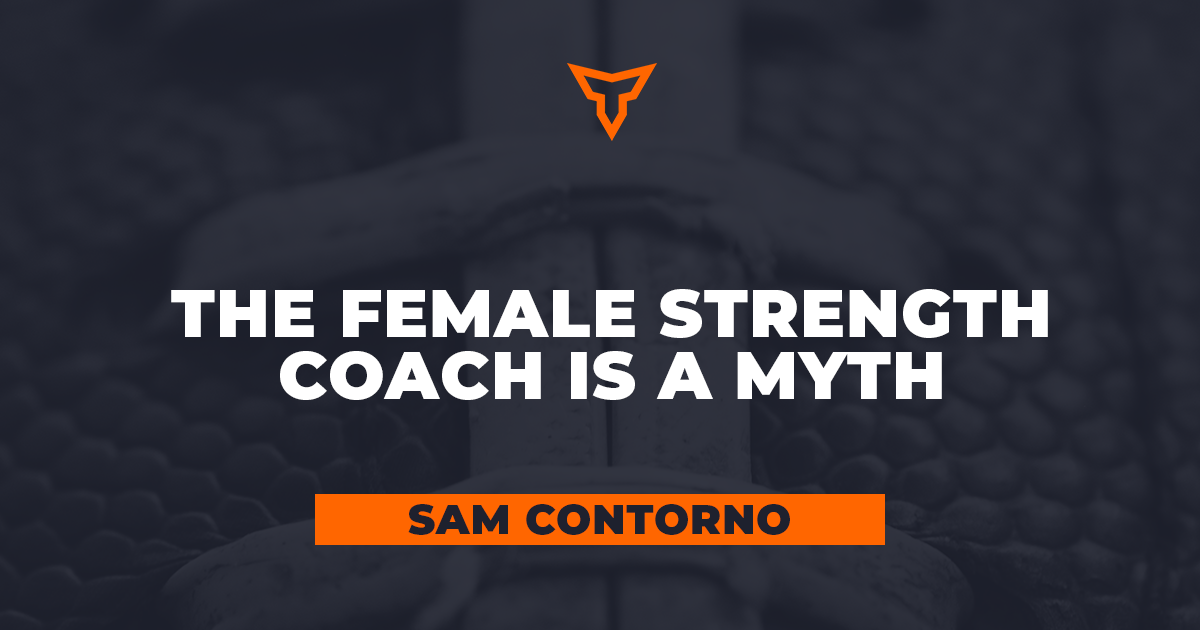
The Female Strength Coach is a Myth
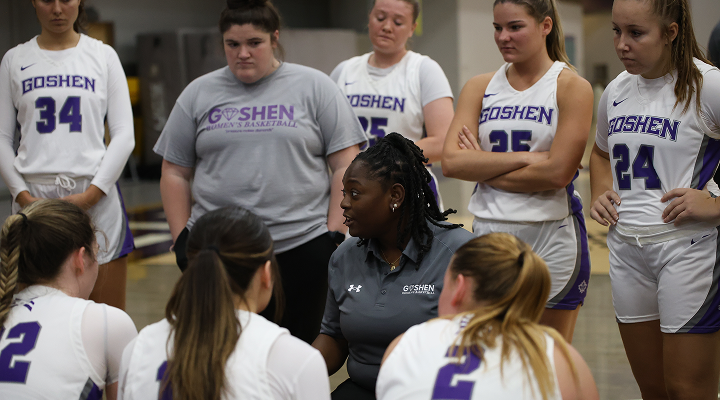
10 Female Strength Coaches You Should Know


